Added Value Assessment Takes Lean to the Next Level
Added Value Assessment Takes Lean to the Next Level
ISE Magazine Mei 2021 Volume: 53 Number: 5
By Jeffrey Miller
https://www.iise.org/iemagazine/2021-05/html/miller/miller.html
Manufacturing is a complex business, and getting more so as global competition increases, customer expectations swell (raising the bar), supply chain disruptions are more prevalent than ever and new technologies (e.g., Industry 4.0) come into their own.
To compete in today’s complex business environment, many companies are embracing a Lean management system. The goal is to delight the customers and improve top and bottom-line results through the relentless elimination of waste.
In reality, that’s much easier said than done. Few companies have achieved the kind of sustained success that Toyota has from its legendary Lean production system. While many companies have implemented “islands of Lean,” what’s often lacking is a comprehensive system. In other words, you may have an ace pitcher on your baseball squad, but if the rest of your team and playbook is lackluster, it’s a challenge to win games, let alone a championship.
So where do you get started if you want to take your Lean program to that next level? The first step is to conduct an added value Lean assessment of your plant to determine the current status, performance gaps and relative “leanness” of your operation. Once you have determined your current state, you can devise a winning game plan. A successful strategy prioritizes improvement opportunities that focus on “the vital few rather than the trivial many” – the 80/20 rule – so your targets are realized within the shortest lead time possible (shown in Figure 1).
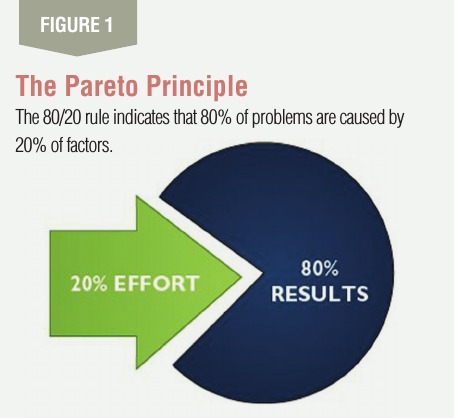
Whether you’re starting a new Lean transformation or contemplating next steps on your journey, the added value Lean assessment is one of the most cost effective and powerful tools available for measuring your Lean index, tracking its progress, comparing operational performance to industry peers, determining gaps that must be closed to improve your “leanness,” and identifying improvement opportunities.
The assessment can also provide quick information on strengths and weaknesses when evaluating a supplier and can be used to establish benchmarks for performance improvement.
Of all the potential benefits, perhaps the most valuable is the ability to hit the ground running on your operations improvement journey. There’s no need for analysis paralysis or a lengthy ramp-up. The assessment will highlight both long-term opportunities and the low-hanging fruit.
How to determine if your factory is truly Lean
Because of the complex nature of manufacturing, it can be difficult to unpack the root causes for various observable symptoms occurring within a factory’s four walls. The law of unintended consequences may result as changes made within one part of the system adversely affect other parts. Often, these new complications are much worse than the original problems. That’s why many performance improvement initiatives fail.
For example, I knew a Tier 1 automotive supplier whose primary focus was on maximizing efficiency. That incentivized production to build large batches in order to amortize lengthy setups, regardless of customer demand or the concept of continuous flow. What do you think that did to lead times, inventory, floor space requirements, quality and return on working capital? It clearly reinforced the wrong behaviors.
The answer is to perform a comprehensive assessment of the production system. When you have a medical condition, a doctor will first conduct an exam and order tests before placing you under the knife. The added value Lean assessment is the equivalent of an exam and tests.
There are many consultants and organizations that provide Lean manufacturing assessments. These assessments are equivalent to conducting a physical exam without ordering lab tests for the patient. They’re qualitative reviews concentrating on Lean principles and practices: How many principles and practices do you have, what are they and how fully are they used? For instance, are work teams trained, empowered and involved in problem-solving and ongoing improvements?
Usually, the more principles and practices an organization has that are considered the industry’s best practice, and the greater the maturity level of those practices, the leaner the organization or process is considered. An example of a qualitative assessment is the rapid plant assessment discussed below.
Similarly, numerous firms offer performance benchmarking services. These studies are comparable to performing lab tests without doing a physical exam on the patient. Quantitative benchmarking centers on measurements of standard performance indicators and comparisons among organizations. For instance, how does your company stack up against the competition in manufacturing cycle time and perfect order fulfillment metrics? Are you an industry leader (in the top 10%) or a laggard (below average)?
Where a qualitative assessment is used to gauge maturity, quantitative benchmarking is used to assess where there are gaps in performance. For instance, a company may be in the bottom half of its class with manufacturing cycle time performance. Perhaps it needs to reduce lead time by two weeks to reach parity, 4½ weeks to fall into the top 25% and six weeks to achieve the top 10% ranking.
Quantitative benchmarking focuses on “what has happened” whereas qualitative assessments tell us “why this happened” (See Figure 2).
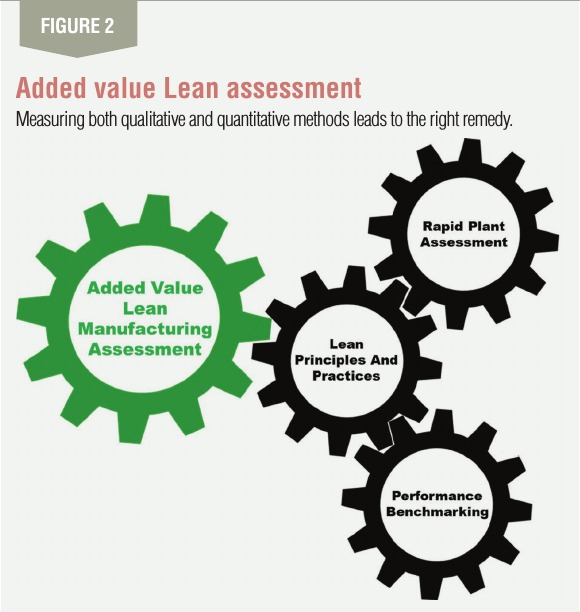
To obtain a holistic view of your factory’s overall health, you need both. An added value Lean assessment provides the best of both worlds – the physical exam and lab tests for the patient. It’s accomplished by integrating the widely recognized tools and techniques of rapid plant assessment, performance benchmarking and Lean principles and practices into a unified framework, creating an extraordinary synergy. Using this mixed methods approach is key to gaining a deeper understanding of your operation along a Lean transformation path. Furthermore, you’ll acquire real evidence and profound insights that lead to identifying and prioritizing those improvement opportunities that generate the best bang for your buck (i.e., the vital few).
The added value Lean assessment is one of the most cost effective and powerful tools available for measuring your Lean index, tracking its progress, comparing operational performance to industry peers, determining gaps that must be closed to improve your “leanness,” and identifying improvement opportunities.
Rapid plant assessment
The rapid plant assessment (RPA) is for quickly evaluating production facilities and identifying improvement opportunities during a plant tour. To the trained eye, a plant tour can reveal a great deal about a company – e.g., Lean operations look Lean and non-Lean operations don’t.
For example, are processes laid out where similar equipment or machines are grouped together, such as all the milling machines in one area, all drill presses in another area and grinding machines in yet another, and so on? Or are processes laid out in a production line or cell consisting of a number of machines or workstations dedicated to produce a family of parts or products that require similar processing? Because one of the key principles of Lean is to “make processes flow,” achieving this with a “traditional” process layout is virtually impossible.
I once visited a plant that had recently rearranged its equipment from a traditional process type layout into U-shaped flow cell configurations. However, I noticed there was significant inventory accumulating between stations within the U-modules. The individual stations and operators were still working as isolated islands. The flow was very intermittent and erratic. They might as well have kept their original layout because it didn’t make them any leaner.
RPA is based on lessons learned from numerous successful applications of Lean manufacturing in North America and European operations and it has been shown to be a reliable indicator of a plant’s strengths and weaknesses.
The RPA process includes two tools for performing the assessment: the RPA rating sheet, which groups more than 200 lean operations attributes into 11 categories for assessing the “leanness” of a plant; and the RPA questionnaire, which provides a series of associated yes-or-no questions to determine if the plant uses Lean principles and best practices in these categories.
Listed below are the 11 categories of Lean assessment from the rating sheet:
- Customer satisfaction.
- Safety, environment, cleanliness and order.
- Visual management system.
- Scheduling system.
- Space use, material movement and product flow.
- Inventory and WIP levels.
- Teamwork and motivation.
- Condition and maintenance of tools and equipment.
- Management of complexity and variability.
- Supply chain integration.
- Commitment to quality.
Performance benchmarking
I believe that Lean, like other performance improvement programs, is a means to achieving a goal, not the end goal itself. At the end of the day, the proof is in the performance. The question is: How will you keep score to know whether or not you’re winning?
Effective benchmarking against industry peers is critical to understand performance gaps. The performance benchmarking assessment (PBA) compares where your company stands relative to organizations in the same, or a similar, industry for key metrics that are aligned to the 11 RPA lean assessment categories. These benchmark metrics will include performance levels of cost, quality, delivery, productivity and safety.
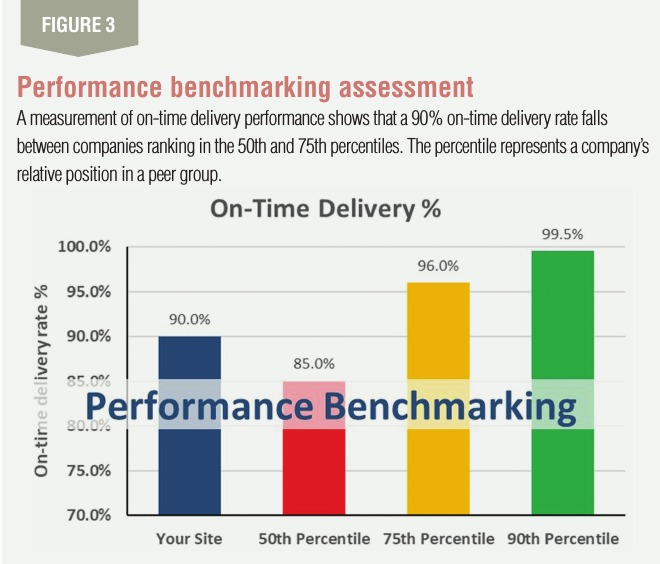
Figure 3 shows a benchmark of on-time delivery performance. A 90% on-time delivery rate falls approximately within the 65% percentile ranking. The percentile represents the relative position in a peer group. For example, if your percentile is 65%, you perform better than 65% of the other companies in the comparison group. Conversely, you perform more poorly than 35% of the other companies in your comparison group.
Leveraging this quantitative benchmarking data will help paint a more complete picture of your plant’s “leanness” by shedding light on critical financial and operational performance.
In addition, some leading companies successfully use this information as a sales tool to improve contract win rates by showing prospective customers how they’re better than their competitors.
The added value Lean assessment process is divided into three phases: 1. pre-assessment and benchmarking; 2. on-site assessment; and 3. post-assessment. Figure 4 displays a high-level flowchart that illustrates the process.
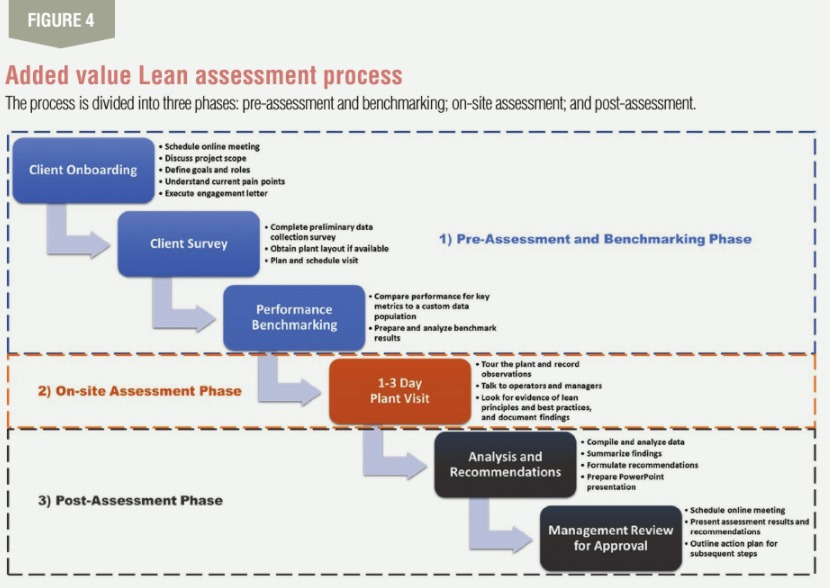
The study culminates in a presentation to management that includes the completed scorecard and charts indicating the current “leanness” of the plant. Shown in Figure 5 is a sample radar chart to visually display a summary of the results. Also included are the competitive benchmarking results showing how your organization stacks up against other relevant industry players for key performance indicators. The presentation also contains major improvement opportunities and best practices needed to further integrate Lean into the organization and move the needle toward performance improvement.
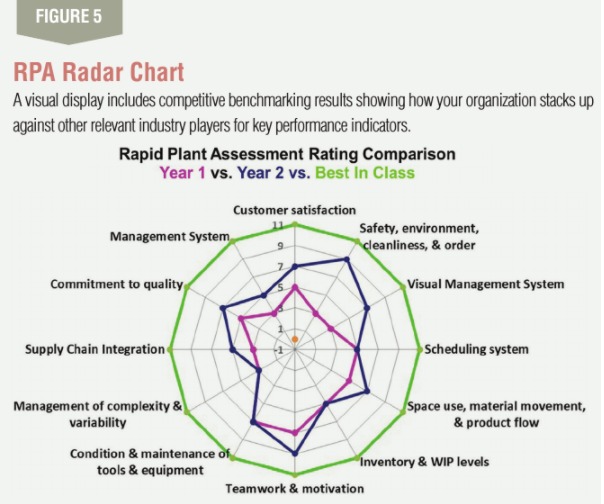
By using this approach, you will not only set the stage for enhancing your Lean production system, but also pave the way for improving your top and bottom lines.
To obtain the maximum benefit, it’s best to engage an independent, third-party expert to conduct the assessment. An experienced professional will bring to bear an impartial perspective with no personal turf to protect. Most of us develop a syndrome of “can’t see the forest for the trees” before long after working at a company. Sometimes if you’re too close to the problem, you need a fresh pair of eyes to objectively analyze and evaluate the situation. A good consultant will play the role of a “best friend” and sometimes tell you things you don’t want to hear, speaking truth to power. Furthermore, an external consultant will use the principle of experience transfer, drawing on situations and best practices from other similar encounters in various industries.
If your goal is to save a few bucks in the short run, then a DIY approach is the answer. However, if your objective is to maximize the value contribution to your company, then an outside professional with no hidden agendas is the way to go.
In the spirit of continuous improvement, it’s vitally important to periodically reassess the leanness of your factory and track its progress. As improvements are made and targets achieved, new priorities will emerge for the subsequent improvement cycle. Consider following an annual cadence to maintain momentum and keep your program on track.
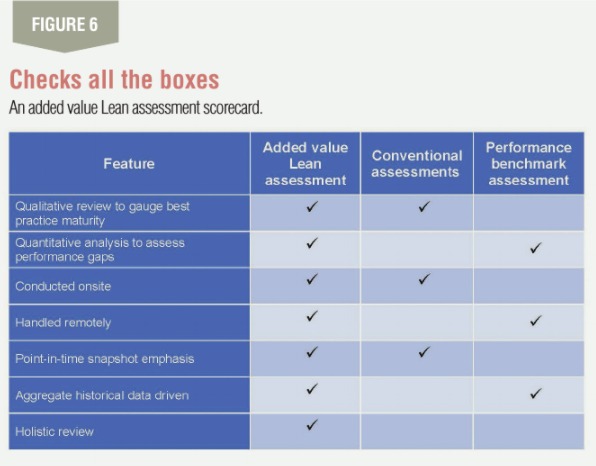
Although the added value lean assessment is no substitute for an in-depth analysis (Figure 6), it is an affordable way to quickly understand your organizations strengths, weaknesses and opportunities for improvement.

Comments :